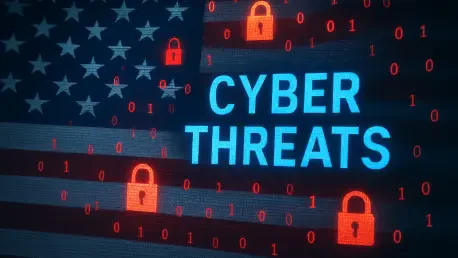In a world where digital connectivity underpins nearly every aspect of daily life, the cyber threat landscape has grown alarmingly complex and dangerous, with risks ranging from state-sponsored disinformation campaigns to billion-dollar cryptocurrency heists. The variety of threats facing individuals, businesses, and governments is staggering. The latest insights from comprehensive cybersecurity bulletins paint a vivid picture of a battlefield where trust in technology is exploited, and innovation often outpaces defense. Communication tools, smart devices, and even the cloud—once seen as secure—are now prime targets for attackers wielding advanced techniques. This exploration delves into the most pressing dangers of the current digital era, shedding light on how these threats disrupt lives and challenge global stability. By examining key trends and specific incidents, a clearer understanding emerges of the urgent need for adaptive strategies to safeguard a hyper-connected society.
The scope of these threats extends far beyond traditional hacking attempts, weaving together social engineering, artificial intelligence, and geopolitical motives. Each incident reveals a piece of a larger puzzle, showing how cybercriminals adapt faster than many defenses can respond. As technology continues to evolve, so too do the methods of exploitation, making vigilance and innovation in cybersecurity more critical than ever. This discussion aims to unpack the chaos, highlighting the major risks shaping this perilous landscape and offering insight into what must be done to stay ahead of the curve.
Trusted Platforms Turned Against Us
The exploitation of trusted platforms stands out as a deeply concerning trend in the current cyber threat environment. Microsoft Teams, a vital tool for corporate communication, has been weaponized by threat actors such as Octo Tempest to orchestrate extortion and ransomware campaigns. These attackers use sophisticated social engineering tactics, including multi-factor authentication hijacking through deceptive password resets, to gain unauthorized access. Once inside, they leverage the platform to send threatening messages or extract sensitive data, exploiting the inherent trust users place in such tools. This manipulation of a widely adopted system underscores a broader vulnerability: the very platforms that enable productivity are becoming gateways for devastating breaches, catching many organizations off guard.
Beyond communication tools, critical software like Autodesk Revit, essential in architectural design, is also under siege due to a severe file-parsing vulnerability identified as CVE-2025-5037. This flaw allows remote code execution, a risk amplified by common cloud misconfigurations that can lead to automatic exploitation. The implications are profound, as attackers can infiltrate networks through software integral to business operations, often bypassing traditional security measures. These incidents highlight a chilling reality—trust in everyday technology is being turned into a weapon, with attackers capitalizing on user familiarity and system integrations to penetrate defenses that were once thought to be robust. The need for heightened scrutiny of even the most relied-upon tools has never been more apparent.
The Rise of AI-Powered Attacks
Artificial intelligence has emerged as a transformative force in the realm of cyber threats, enabling attackers to execute campaigns of unprecedented scale and deception. A striking example is the PRISONBREAK campaign, reportedly linked to Israeli interests, which deploys AI-generated deepfakes and propaganda on social media to target Iranian citizens with the aim of inciting unrest. This use of technology to manipulate perceptions and influence behavior on a mass scale demonstrates how AI can distort reality, creating challenges for both individuals and governments trying to discern truth from fabrication. The implications of such tactics extend far beyond immediate targets, raising concerns about the potential to destabilize entire regions through digital means alone.
Equally alarming are the innovative ways AI facilitates covert data theft, as seen in academic research from UC Irvine with the development of the Mic-E-Mouse technique. This method transforms ordinary optical mice into covert microphones using high-performance sensors and neural networks, enabling data exfiltration from air-gapped systems with startling accuracy. Additionally, North Korean hackers have harnessed AI to fabricate identities, securing remote IT jobs that funnel significant funds to state programs. These advanced techniques reveal a critical gap in traditional security frameworks, which struggle to counter the stealth and sophistication of AI-driven attacks. As technology becomes both a tool and a target, the urgency to develop countermeasures that can match this pace of innovation grows exponentially.
High-Stakes Targets in the Crosshairs
The focus on high-value targets has intensified, with cybercriminals zeroing in on assets that promise substantial financial or strategic returns. North Korean hackers have set a grim record with $2 billion in cryptocurrency thefts, including the staggering $1.46 billion Bybit hack, marking this year as the most lucrative for such crimes. Their strategy has shifted toward high-net-worth individuals who often lack robust security measures, making them easier prey for precision attacks. This trend illustrates a calculated approach where the potential payoff justifies the effort, pushing financial gain to the forefront of many cybercriminal agendas and exposing significant vulnerabilities in personal and institutional defenses alike.
Cloud environments, particularly AWS, are also prime battlegrounds for groups like the Crimson Collective, who employ tools such as TruffleHog to steal credentials and extort victims with ties to notorious actors like Scattered Spider. In Latin America, financial institutions grapple with the BlackStink malware campaign, which uses malicious Chrome extensions to facilitate real-time fraudulent transactions through WebInject overlays. These attacks underscore a clear pattern: threat actors prioritize targets with the greatest value, exploiting gaps in security posture to maximize impact. The convergence of financial and technological assets as focal points for breaches signals an urgent need for specialized protections tailored to these high-stakes environments, lest the losses continue to mount.
Navigating the Security-Privacy Dilemma
The tension between bolstering security and preserving convenience and privacy remains a central challenge in the digital age. The European Union’s proposed Chat Control regulation, which mandates mass scanning of encrypted communications on platforms like Signal, has ignited fierce opposition from tech companies and privacy advocates. Critics argue that such measures could pave the way for mass surveillance, undermining the fundamental right to private communication under the guise of safety. This debate reflects a broader struggle to define the limits of governmental oversight in an era where digital interactions are ubiquitous, raising critical questions about how to protect society without sacrificing individual freedoms.
Adding to this complex issue is France’s ongoing investigation into Apple’s Siri voice recordings, prompted by whistleblower claims of sensitive data exposure. Despite assurances from Apple that such data isn’t used for commercial purposes, public trust hangs in a delicate balance, with many questioning the safeguards around personal information captured by everyday devices. These controversies highlight an essential conflict: implementing effective security often risks eroding user confidence or enabling overreach. Striking a balance that prioritizes both protection and privacy is proving to be an elusive goal, as stakeholders across industries and governments grapple with competing priorities in a landscape where every solution seems to introduce new vulnerabilities.
Geopolitical Cyber Warfare and Hacktivism
Cyber threats are increasingly intertwined with geopolitical tensions, serving as tools of statecraft that extend conflicts into the digital realm. The PRISONBREAK campaign targeting Iranian citizens with AI-driven disinformation is believed to be backed by Israeli interests, showcasing how cyber operations can influence political outcomes far beyond borders. Similarly, North Korea’s cyber activities, including massive cryptocurrency thefts, directly fund state ambitions such as nuclear programs, blending financial crime with national strategy. These incidents reveal a troubling reality where digital attacks are not just about profit but are leveraged to shape global power dynamics, complicating efforts to address them through conventional means.
Hacktivist groups further muddy the waters, with entities like NoName057(16) targeting Western infrastructure, particularly in Germany, despite international law enforcement efforts such as Operation Eastwood. Operating from bases in Russia with apparent impunity due to a lack of cooperation, these actors highlight the challenges of combating cyber threats when geopolitical rivalries hinder unified responses. The persistence of such groups underscores how ideological and political motives fuel a new era of digital conflict, often outpacing the ability of nations to coordinate defenses. As cyber warfare becomes a proxy for physical confrontations, the need for international frameworks to address these threats grows more pressing, though solutions remain frustratingly out of reach.
Vulnerabilities in Connected Devices and IoT
The proliferation of connected devices through the Internet of Things (IoT) has opened up new frontiers for cyber attackers, turning everyday technology into potential entry points. Vulnerabilities in the YoLink Smart Hub, identified as CVE-2025-59449 among others, allow unauthorized access and control over connected devices, potentially enabling attackers to unlock doors or disable security systems in homes. This breach of physical safety through digital means is a stark warning of how interconnected systems can transform minor flaws into major risks. As smart homes become more common, the attack surface expands, exposing users to threats that transcend data theft and venture into tangible harm.
Hardware vulnerabilities add another layer of concern, exemplified by Tesla’s Traffic Control Unit (TCU) flaw, cataloged as CVE-2025-34251, which permits root access through physical USB exploitation. Such weaknesses in critical systems demonstrate that even high-end technology is not immune to exploitation, especially when physical access is a factor. The growing network of IoT and hardware devices, while enhancing convenience, simultaneously creates a goldmine for malicious actors seeking to exploit unpatched or overlooked vulnerabilities. Addressing these risks requires a fundamental shift in how security is integrated into the design and deployment of connected technologies, as the consequences of failure could be both digital and devastatingly real.
Charting a Path Forward Through Cyber Chaos
Reflecting on the myriad cyber threats that defined this year, it became evident that the digital domain had evolved into a complex arena of unprecedented challenges. State-sponsored campaigns, AI-driven deceptions, and the exploitation of trusted platforms had reshaped the nature of risk, leaving no sector untouched. High-value targets faced relentless assaults, while privacy debates and geopolitical tensions had compounded the difficulty of crafting effective responses. Vulnerabilities in IoT and hardware had further blurred the line between digital and physical safety, demanding urgent attention.
Looking ahead, actionable steps emerged as essential to navigate this chaos. Strengthening defenses around trusted platforms through rigorous identity protection and endpoint security had proven critical. Investment in AI countermeasures to detect and disrupt deceptive campaigns was no longer optional but necessary. Collaborative international efforts to address state-backed threats and hacktivist actions had shown promise, even if progress was slow. Above all, integrating security into the design of connected devices offered a proactive way to shrink the expanding attack surface. These strategies, built on lessons learned, provided a roadmap to rebuild trust and resilience in a world where cyber threats would undoubtedly continue to evolve.









